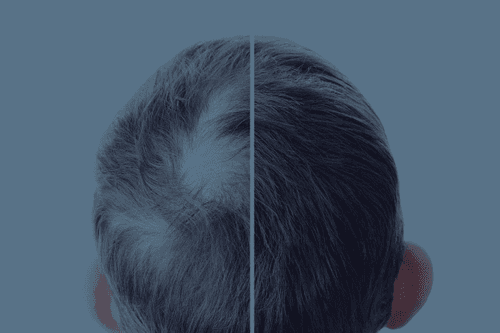Hair Transplant Success Stories: Before and After
Many people will experience some form of alopecia, or hair loss, at some point in their lives.
Many people will experience some form of alopecia, or hair loss, at some point in their lives.

Many people will experience some form of alopecia, or hair loss, at some point in their lives. Of those that lose their hair, a great number will experience permanent hair loss, which can be quite traumatic – regardless of the cause. A number of medical options are available for treatment for those experiencing thinning hair or more dramatic loss. Hair transplant surgery can be a viable option for people suffering from androgenetic alopecia, or the most common kinds of hair loss.
Obviously, people should consider less invasive treatment plans before moving to a surgical option. Any kind of surgery can have risks, and it is generally accepted medical practice to exhaust safe, sensible treatments before choosing surgery.
There are a number of pharmaceutical products on the market that treat hair loss. For many, these medications, either over-the-counter or prescription, can be the answer. Advances in laser technology has made at-home light therapies convenient and affordable. Spending a few minutes a day in a comfortable, wearable device can stimulate hair growth for some. More aggressive treatments, like platelet rich plasma or PRP, can also yield results. By supplying the scalp with nutrient-rich plasma, hair follicles can build their own stronger, thicker, natural hair.
If your hair loss specialist determines that transplant is not necessary, and that a hairline has stopped receding, hairline lowering might be the best course of action. Hairline lowering takes advantage of healthy hair growth that simply is not covering enough of one’s forehead.
When these and any other sensible options have not provided someone with satisfactory results, it may be time to speak to a hair transplantation specialist. Board certified medical professionals now have access to precise, automated systems that provide the most minimally invasive experience possible in a procedure called follicular unit extraction.
Unlike other hair transplantation, follicular unit extraction or FUE, takes tiny grafts from a donor region of skin and implants them in the desired recipient area. The follicular unit excision is performed with a micropunch tool and are typically smaller than a millimeter – not like the old method, when strips of healthy skin and follicles were taken, leaving scars that need to be concealed. FUE hair transplantation has proven to be very effective, with great-looking results.
The great thing about treating hair loss with follicular unit extraction is that it can treat both men and women. The excisions are spread over a donor area where hair loss is not an issue and transfers it to places where more hair growth is desired. Because it is the patient’s own hair, the resulting growth doesn’t just look natural, it is natural. The region where the hair follicles were harvested from heals with little negative impact on the skin.
People can expect to have anywhere from several hundred to a few thousand hair follicles transplanted. The procedure is outpatient in nature, meaning no overnight hospital stay and patients can expect to see results quickly.
Gone are the days of looking like one of your daughter’s dolls. FUE provides greater precision and targeted insertion of the grafted follicles. Men suffering from any types of receding hairline, regardless if you’re just getting a little deep in the power allies or have full-blown male-pattern baldness, can see full, natural hair growth in months. Women with thinning hair or high foreheads can experience normal hair growth soon after a procedure.
A professional hair transplant specialist is a medical professional that has trained in the latest technology and techniques. Your specialist will take many factors into account to provide you with the best potential for success. This includes determining a patient’s physical features and the actual hair density. It does not pay to get a hair transplant if the post-op results are not going to look good.
The best way to avoid the dreaded “hair plug” look is to have a well-planned procedure or procedures that move the appropriate amount of follicles in a manner that limits swelling and actually promotes healing. Be aware that such results may warrant multiple procedures. Your hair restoration professional will be able to determine the best treatment plan.
Hair transplant technology has helped bring the cost of follicular unit extraction transplants down, but that does not mean that it is inexpensive. Like any cosmetic procedure, you’re going to need to be prepared to invest thousands of dollars. FUE may take several visits to complete the procedure and that can drive up the cost into the tens of thousands.
Follicular unit extraction is not a magic wand. For a hair transplant to work, a patient must have realistic expectations. First, it is a medical procedure and can be uncomfortable during recovery. There is a risk of infection, though the automated micropunch tool helps limit this. Hair growth can take weeks or even months for a patient to see desired results. There may be some inconveniences during the recovery period, like limiting smoking or drinking, or not wearing hats. Hair follicles could swell, a condition called folliculitis, but usually can be resolved. In some cases, hair may not regrow, but for most that take this option, the tides of hair loss can be stopped.
FUE provides thousands of satisfied parents with a real, permanent solution to thinning hair and hair loss. As you can see from these images of successful hair transplants, the results are naturally growing hair that looks great.
HAIRMD is based in Englewood NJ and proudly in Bergen County and across Northern New Jersey. Schedule a consultation with Dr. Herbert Feinberg and get personalized advice on your best hair restoration options.